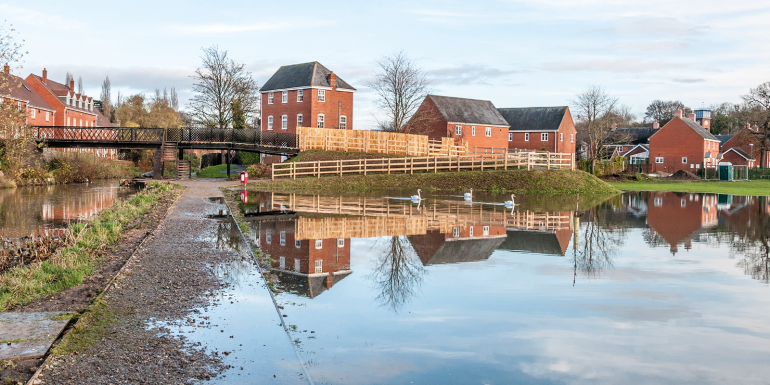The practical challenges of building on floodplains

With heavy rain intensifying and authorities under pressure to provide homes, how do developers successfully build on floodplains? Raj Somal, Director at sustainable engineering consultancy Dice, explores the issues.
Heavy rains and the subsequent flooding that comes with them are becoming more common. Figures from the Met Office have shown it was around 1% wetter in 2009-18 than in 1981-2010, and 5% wetter than in 1961-90. According to figures from the Environment Agency, more than 5.2 million homes and properties in England are at risk from flooding and coastal erosion. With the UK currently experiencing heavy rainfall and the threat of flooding, as well as 5,000 new homes being approved for construction on floodplains in 2021, you can see the problem.
A floodplain is an area of land (generally flat) adjacent to a river or a small watercourse that is a continuation of the channel and allowed to flood when the river overflows. Building here reduces the area that is allowed to flood, so when the same amount of water (or more) enters it gets displaced and increases the risk of flooding elsewhere.
When building within Flood Zones 2, 3a and 3b (see Flood zone definitions), the kind of development that is allowed to be built is determined based on the vulnerability of the infrastructure versus the risk level of the flood zone. When proposing to build within these flood zones, you must prove that you are not increasing the flood risk elsewhere.
This is done by undertaking flood modelling and providing flood compensation in some cases.
Reducing the flood risk
Current regulations state that sustainable drainage needs to be incorporated within the proposals. This can be anything from attenuation ponds and permeable paving to filter drains, swales or storage tanks. Essentially, sustainable drainage provides surface water storage on-site, as well as water quality improvement and biodiversity benefits.
Attenuation is simply the storing of excess water on-site, prior to discharging at a lower rate to a suitable drainage outfall. The new rate can either be based on greenfield run-off rates (which is the rate at which the water would have drained if the site were open greenfield) or decreased brownfield rate (which is the discharge rate that is being generated from the existing impermeable areas being positively drained on-site, making provision for the water to get drained within the shortest possible time. This includes betterment, which is a reduction in rates of surface water runoff – usually a percentage of the calculated predevelopment runoff rate). This is to ensure that the rates being proposed to leave the site are lower than the current rates, therefore ensuring reduced flood risk downstream.
With regards to properties already built on floodplains, the options are limited when it comes to keeping out excess water. Homeowners can introduce physical barriers such as a blockwork/masonry wall or a flood defence. Damage mitigation measures are also important. These can include carefully choosing materials for inside the home (certain flooring options, for example, will be less susceptible to water damage than others) or placing electrical sockets higher off the ground.
There is no one solution to addressing climate change impacts, but it is clear that developers and planners must ensure there is sustainable drainage alongside buildings that are more resilient to flooding.
For more, visit diceconsult.co.uk










